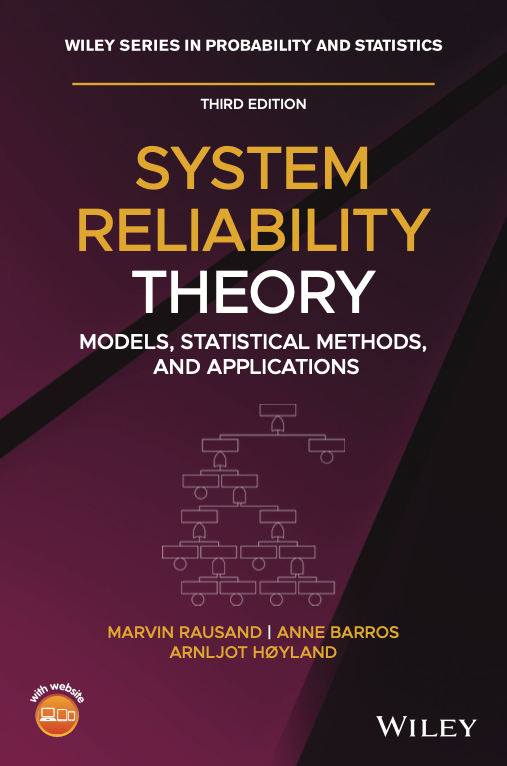In this repository you will find scripts, datasets, examples developped in the book "System Reliability Theory; Models, Statistical Methods and Applications" by M. Rausand, A. Barros, A. Høyland.
1. Repository description
2. Get the repository
3. Get the environment
4. Bug reports
5. License
To facilitate the understanding of notebooks, we tried to minimize the call to external subfunctions. The advantage is that notebooks are independent and subfunctions are directly defined at the notebook level and are rather simple. The inconvenient is that several notebooks have the same subfunctions and that they might slightly differe from one to another... The reader should be aware of that.
Below is a tree view of the repository relying on the book's sections numbering:
.
├── 05_ProbabilityDistributionsInReliabilityAnalysis
│ ├── 05_04_SomeTimeToFailureDistributions --> R Code
│ │ ├── 05_04_02_TheGammaDistribution.ipynb --> R Code
│ │ ├── 05_04_03_TheWeibullDistribution.ipynb --> R Code
│ │ ├── 05_04_04_TheNormalDistribution.ipynb --> R Code
│ │ └── 05_04_05_TheLognormalDistribution.ipynb --> R Code
│ └── 05_07_AdditionalContinuousDistributions
│ └── 05_07_02_TheBetaDistribution.ipynb --> R Code
├── 06_SystemReliabilityAnalysis
│ └── 06_03_NonRepairableSystems
│ └── 06_03_02_NonrepairableParallelStructures.ipynb --> R Code
├── 10_CountingProcesses
│ └── 10_07_Problems
│ ├── 10_07_Dataset_Problem_10_13.txt --> Dataset
│ └── TestDataLoading.ipynb --> R Code
├── 11_MarkovAnalysis
│ ├── 11_09_TimeDependentSolution.ipynb --> Python
│ ├── 11_11_MultiphaseMarkovProcesses
│ │ ├── 11_11_01_ChangingTheTransitionRates.ipynb --> Python
│ │ └── 11_11_02_ChangingTheInitialState.ipynb --> Python
│ ├── 11_12_PiecewiseDeterministicMarkovProcesses
│ │ └── 11_12_03_ASpecificCase.ipynb --> Python
│ └── 11_13_SimulationOfAMarkovProcess.ipynb --> Python
├── 12_PreventiveMaintenance
│ ├── 12_04_DegradationModels
│ │ ├── 12_04_02_TrendModelsRegressionBasedModels.ipynb --> Python
│ │ └── 12_04_03_ModelsWithIncrements.ipynb --> Python
│ └── 12_05_ConditionBasedMaintenance
│ ├── 12_05_02_ContinuousMonitoringAndFiniteDiscreteStateSpace1.ipynb --> Python
│ ├── 12_05_02_ContinuousMonitoringAndFiniteDiscreteStateSpace2.ipynb --> Python
│ ├── 12_05_02_ContinuousMonitoringAndFiniteDiscreteStateSpace3.ipynb --> Python
│ ├── 12_05_04_InspectionBasedMonitoringAndFiniteDiscreteStateSpace.ipynb --> Python
│ └── 12_05_05_InspectionBasedMonitoringAndContinuousStateSpace.ipynb --> Python
├── 14_ReliabilityDataAnalysis
│ ├── 14_02_SomeBasicConcepts
│ │ └── 14_02_02_SurvivalTimes.ipynb --> R Code
│ ├── 14_03_ExploratoryDataAnalysis
│ │ ├── 14_03_01_ACompleteDataset.ipynb --> R Code
│ │ ├── 14_03_02_SampleMetrics.ipynb --> R Code
│ │ ├── 14_03_03_Histogram.ipynb --> R Code
│ │ ├── 14_03_04_DensityPlot.ipynb --> R Code
│ │ ├── 14_03_05_EmpiricalSurvivorFunction.ipynb --> R Code
│ │ ├── 14_03_06_QQPlot.ipynb --> R Code
│ │ └── 14_03_dataset.txt --> Dataset
│ ├── 14_04_ParameterEstimation
│ │ ├── 14_04_03_MethodOfMomentsEstimation.ipynb --> R Code
│ │ ├── 14_04_04_MaximumLikelihoodEstimation.ipynb --> R Code
│ │ ├── 14_04_06_WeibullDistributedLifetimes.ipynb --> R Code
│ │ └── 14_04_dataset.txt --> Dataset
│ ├── 14_05_TheKaplanMeierEstimate
│ │ └── 14_05_02_TheKaplanMeierEstimatorForACensoredDataset.ipynb --> R Code
│ ├── 14_06_CumulativeFailureRatePlots
│ │ └── 14_06_01_TheNelsonAalenEstimateOfTheCumulativeFailureRate.ipynb --> R Code
│ ├── 14_07_TotalTimeOnTestPlotting
│ │ └── 14_07_01_TotalTimeOnTestPlotForCompleteDatasets.ipynb --> R Code
│ └── 14_09_Problems
│ ├── 14_09_Dataset_Problem_14_01.txt --> Dataset
│ ├── 14_09_Dataset_Problem_14_02.txt --> Dataset
│ ├── 14_09_Dataset_Problem_14_03.txt --> Dataset
│ ├── 14_09_Dataset_Problem_14_11.txt --> Dataset
│ ├── 14_09_Dataset_Problem_14_12.txt --> Dataset
│ ├── 14_09_Dataset_Problem_14_13.txt --> Dataset
│ ├── 14_09_Dataset_Problem_14_16.txt --> Dataset
│ ├── 14_09_Dataset_Problem_14_17.txt --> Dataset
│ ├── 14_09_Dataset_Problem_14_18.txt --> Dataset
│ └── TestDataLoading.ipynb --> R Code
├── 15_BayesianReliabilityAnalysis
│ └── 15_03_SelectionOfPriorDistribution
│ └── 15_03_01_BinomialModel.ipynb --> R Code
├── ReliabilityBookEnv.yml --> Environment definition
├── LICENSE.txt --> License
└── README.md
To get the repository, run:
git clone https://github.com/RausandBarros/ReliabilityBookScripts.gitor simply download it as ZIP file from the GitHub page.
The link with the repository may be removed by deleting the \.git folder.
Anaconda is a package and environment manager. It is a common practice to dedicate a specific environment to each project to ensure its consistency and limit potential interdependence with other projects. This is especially needed when several people share/work on the same project. In the following, we assume that Anaconda’s latest version (Python 3.7) https://www.anaconda.com/distribution/ is installed on your computer (Windows, macOS or Linux) and is up to date.
Use command line interface:
- Windows: click Start, search or select Anaconda Prompt from the menu
- macOS or Linux: open a terminal window
Run command with the path to the file ReliabilityBookEnv.yml correctly set:
conda env create -f ./MY/PATH/TO/ReliabilityBookEnv.ymlYou should be able to check the installation by running the following command that list installed environments (i.e. ReliabilityBookEnv):
conda env listStill from the command line interface, start the ReliabilityBookEnv environment by running the command:
conda activate ReliabilityBookEnvThen, launch Jupyter with the command:
jupyter notebookThen use Jupyter's interface to move to the folder where the repository has been cloned or copied.
Here are the instructions: - to install the python's environment according to this repository Requirements; - to run Jupyter and therefore the notebooks provided within this repository.
At the end of the session, deactivate the environment with command:
conda deactivateThe environment might be deleted with command:
conda remove --name ReliabilityBookEnv --allBug reports would be appreciated and may be filed through the issue tracker. Pull requests won't be accepted except by invitation. Please file an issue first through the former link.
This project is licensed under the terms of the MIT license (see file License.txt).
